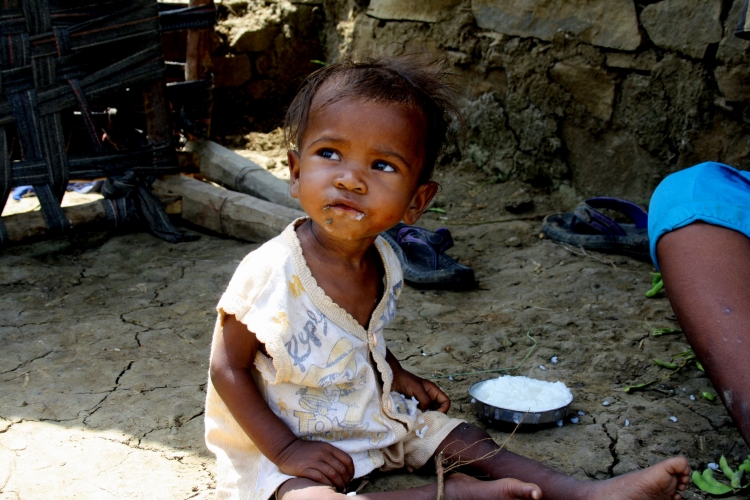Nutrition norms issued to tackle severe acute malnutrition
In News
India’s top nutrition panel National Technical Board on Nutrition (NTBN) has recommended that severely malnourished children must be fed freshly cooked food prepared from locally available cereals, pulses and vegetables, and distributed by anganwadi centres, as part of the country’s first-ever guidelines for nutritional management of children suffering from severe acute malnutrition (SAM). The measures are part of the community-based health management of children suffering from SAM. The government had, till now, only put in place guidelines for the hospitalisation of severely wasted children who develop medical complications. Those norms were made public in 2011.
The guidelines outline the role of anganwadi workers and auxillary nurse midwives (ANMs) in identifying severely wasted children, segregating those with oedema or medical complications and sending them to the nearest health facility or nutrition rehabilitation centres. The remaining children are enrolled into “community based management”, which includes provision of nutrition, continuous monitoring of growth, administration of antibiotics and micro-nutrients as well as counselling sessions and imparting of nutrition and health education.
What is severe acute malnutrition (SAM)?
Severe acute malnutrition is the most extreme and visible form of undernutrition. Its face is a child – frail and skeletal – who requires urgent treatment to survive. Children with severe acute malnutrition have very low weight for their height and severe muscle wasting. They may also have nutritional oedema – characterized by swollen feet, face and limbs. About two thirds of these children live in Asia and almost one third live in Africa. Severe acute malnutrition is a major cause of death in children under 5, and its prevention and treatment are critical to child survival and development. Across the globe, an estimated 16 million children under the age of 5 are affected by severe acute malnutrition.
How is severe acute malnutrition prevented and treated?
Ending acute malnutrition is a complex social and political challenge. Prevention and long term solutions involve dismantling unequal power structures, improving equitable access to health services and nutritious foods, promoting breastfeeding and optimal infant and young child feeding practices, improving water and sanitation, and planning for cyclic food shortages and emergencies. But in the short term, children with severe acute malnutrition need urgent life saving treatment to survive. Until relatively recently, these children were only treated in hospitals where they received therapeutic milks along with medical care; and many more were never reached at all. With the creation of ready-to-use therapeutic food (RUTF) however, the picture has changed dramatically.
Ready-to-use therapeutic food (RUTF) is a high-energy, micronutrient enhanced paste used to treat children under age 5 who are affected by severe acute malnutrition. As its name implies, RUTF does not need to be cooked or prepared before consumption. This makes it a practical solution where cooking facilities and fuel are limited. RUTF has a long shelf life and is safe for use even in the absence of clean drinking water.
National Technical Board on Nutrition (NTBN) – Constitution & Role
Governent of India has decided to constitute ‘NTBN’ under the chairmanship of Dr.Vinod Paul, Member, NITI Aayog to make technical recommendations on policy relevant issues on Nutrition. (Dec 2017) The role of the Board would be advisory and specific in terms of synthesis of technical evidence, analysis and evidence based technical recommendations, responsive to the local context. The NTBN shall meet once in three months to review technical recommedations on policy relevant issues in Nutrition. The Board for their day-to-day work shall be serviced by the concerned Divisions of NITI Aayog.
Also know about POSHAN Abhiyaan
Prime Minister’s Overarching Scheme for Holistic Nutrition was launched in Jhunjhunu, Rajasthan in March 2018. The Abhiyaan targets to reduce stunting, under-nutrition, anemia (among young children, women and adolescent girls) and reduce low birth weight by 2%, 2%, 3% and 2% per annum respectively.The target of the mission is to bring down stunting among children in the age group 0-6 years from 38.4% to 25% by 2022.
Ministry of Women and Child Development has said that the following components will form the pillars of the Mission :
- ICDS-CAS(Common Application Software)
- Convergence
- Behavioural change, IEC Advocacy
- Training and Capacity building
- Innovations
- Incentives
- Grievance Redressal
Also Read about AYUSHMAN BHARAT - Pradhan Mantri Jan Aarogya Yojana, nicknamed Modicare, is a program which aims to provide a service to create a healthy, capable and content new India. Presently it is running as a pilot project in Uttar Pradesh from 4 September 2018.
https://www.kamarajiasacademy.com/blog/27/ayushman-bharat/


 "UPSC-2026-PRELIMS COMBINED MAINS PROGRAMME" NEW BATCH STARTS WITH ORIENTATION ON JULY 7th,2025
"UPSC-2026-PRELIMS COMBINED MAINS PROGRAMME" NEW BATCH STARTS WITH ORIENTATION ON JULY 7th,2025 